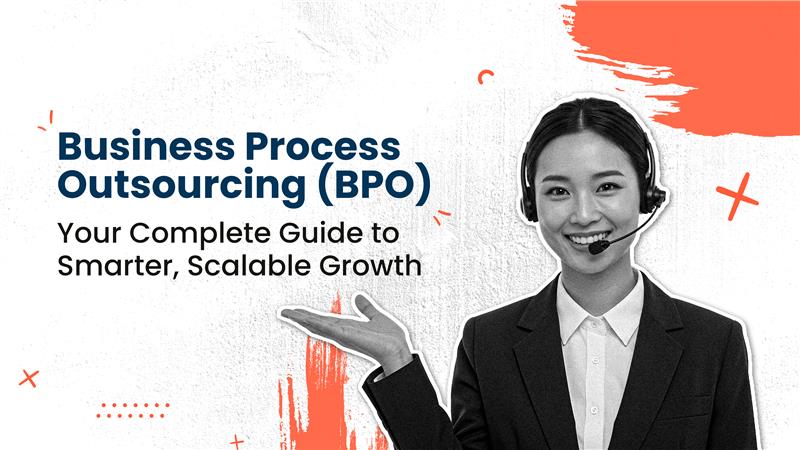
- What is Business Process Outsourcing?
- Top BPO Services: Common Functions Businesses Outsource
- Benefits of Outsourcing with a BPO
- Outsourcing Stats & Trends in 2025
- What Industries Benefit Most from BPO?
- How to Choose the Right BPO Partner
- Real BPO Success Stories
- Wally Health
- American Exchange Group
- How Peak Support Helps Businesses Succeed
- Business Process Outsourcing FAQs
Business leaders today are under constant pressure to do more with less— from streamlining operations and elevating customer experience to staying competitive in an increasingly global marketplace. Rising customer expectations mean companies can’t afford to let service or quality slip while keeping costs in check. These demands often stretch internal teams thin, making it challenging to maintain high performance across every function. One strategy that has helped brands of all sizes meet these challenges is business process outsourcing (BPO), which enables teams to focus on core, more strategic priorities while specialized partners handle key operational functions.
In this guide, we’ll cover everything you need to know about BPO, including:
- How business process outsourcing works – including an overview of the different outsourcing models
- The role of a BPO partner in modern business
- Benefits of outsourcing
- Which industries serve to gain the most from BPO and what services they most commonly outsource
- How to determine if outsourcing is right for your business
- What to look for in a BPO partner
- Real-world BPO case studies and success stories
Whether you’re new to outsourcing or simply evaluating your next step, this guide will provide you with the knowledge needed to make an informed decision about whether partnering with a BPO is the right move for your organization.
What is Business Process Outsourcing?
Business process outsourcing is the practice of contracting specific business functions to an external partner. Instead of hiring, training, and managing an in-house team for every task, companies can outsource processes—such as customer service, IT support, accounting, or HR—to specialized providers.
Put simply, BPO allows organizations to focus on their core business functions while leaving routine or resource-heavy tasks to external experts. While many companies initially turn to BPO for cost savings, the practice now offers broader strategic advantages, including improved operational efficiency, enhanced customer experiences, and greater flexibility to scale.
Outsourcing Models: Understanding How BPO is Structured
Not all outsourcing looks the same. Companies can choose from several outsourcing models, depending on goals like cost, proximity, and language or cultural alignment.
The different outsourcing models include:
- Onshore Outsourcing (Domestic BPO): Work is outsourced to a provider within the same country. While it may come at a higher price point, this model ensures easier communication, time zone alignment, and cultural fit.
- Nearshore Outsourcing: Services are contracted to a nearby country, often with similar time zones and cultural understanding. For U.S. companies, this might mean Mexico or Latin America.
- Offshore Outsourcing: Processes are handled in distant countries, often in Asia or Eastern Europe, where labor costs are lower. This can deliver significant cost savings, though time zone differences may require adjustments.
- Hybrid Outsourcing: A combination of onshore, nearshore, and offshore BPO support, offering flexibility to balance cost savings with accessibility and control.
Each model has its own set of pros and cons—from offshore BPO’s affordability to onshore outsourcing’s closer alignment. Choosing the right approach depends on your company’s priorities, whether it’s budget efficiency, real-time collaboration, or regulatory compliance.
Interested in a deeper dive into these models? Check out our blog: Outsourcing Models Explained: How Onshore, Nearshore, Offshore, and Hybrid Work.
Top BPO Services: Common Functions Businesses Outsource
BPO providers support a wide range of business functions, allowing your in-house team to prioritize more strategic initiatives. These services generally fall into two categories: Front-office outsourcing and back-office outsourcing.
Front-Office Outsourcing
These are customer-facing processes that directly impact experience and brand perception:
- Customer Service: Call centers, live chat, email support, multilingual support.
- Technical Support: Product troubleshooting, IT helpdesks.
- Trust & Safety: Content moderation, fraud detection, community monitoring.
- Sales & Marketing: Lead generation, outbound calling, customer engagement campaigns.
Back-Office Outsourcing
These are internal operations that keep your company running smoothly:
- Back Office Support: Administrative tasks, data entry, HR support.
- Accounting Services: Bookkeeping, payroll, accounts payable/receivable, financial reporting.
- Tech & AI Services: IT infrastructure management, software development, AI tool integration, and system maintenance.
By dividing responsibilities this way, companies can improve efficiency across both front- and back-office services while keeping their internal teams focused on growth and innovation.
The Role of a BPO in Modern Business
So, what does a BPO do beyond handling tasks? Today’s BPOs act as strategic partners that evolve with client needs. Here’s how:
- They help companies differentiate in competitive markets by improving customer experience.
- They provide flexibility for organizations to scale quickly during seasonal peaks or new market launches.
- They bring expertise and technology that might be too costly to build in-house.
BPOs don’t just reduce costs. They provide access to specialized talent, enhance operational resilience, and can even help design customer experiences that strengthen loyalty.
Curious about other common misconceptions around outsourcing? Read our blog: Common BPO Misconceptions Debunked—What Outsourcing Really Means for Your Business.
Benefits of Outsourcing with a BPO
The advantages of outsourcing extend across multiple areas of business. Key benefits of BPO include:
- Cost Savings: Reduce overhead without sacrificing quality.
- Efficiency: Outsourced teams are trained and equipped to handle tasks quickly and accurately.
- Access to Global Talent: Tap into specialized skills worldwide.
- Flexibility & Scalability: Support can expand or contract as business needs change. Expand support during peak seasons, scale down during slow periods.
- Expertise: BPO providers bring deep knowledge in specialized functions.
- Risk Reduction: Mitigate compliance, staffing, and operational risks.
- Focus on Core Activities: Free internal teams to prioritize growth and innovation.
- 24/7 Support & Global Reach: Provide around-the-clock service without the need for building a global in-house team.
For a closer look at the operational impact, check out our blog: The Top Three Benefits of Outsourcing Operations.
Outsourcing Stats & Trends in 2025
Business Process Outsourcing continues to play a critical role in helping companies streamline operations, reduce costs, and focus on core business priorities. In 2025, the global BPO market is projected to surpass $350 billion, reflecting steady growth as organizations increasingly rely on external partners for non-core business functions.
The following statistics illustrate just how integral BPO has become for modern organizations:
- 66% of U.S. businesses outsource at least one department, showing how prevalent BPO has become in modern organizations.
- The average company outsources 4–5 business processes, ranging from customer service to finance and IT support.
- Organizations report that outsourcing drives efficiency gains, access to specialized expertise, and the ability to scale operations quickly.
- BPO adoption is not limited to large enterprises: SMBs are increasingly leveraging outsourcing to compete with bigger players without adding full-time staff.
- The most frequently outsourced processes in 2025 include: Customer experience (CX) and contact center operations, finance and accounting, information technology (IT) support, human resources (HR), and e-commerce operations and order management.
- Modern companies are leveraging BPO for more than just cost savings. This approach offers multiple strategic advantages, including access to specialized skills and technologies without large internal investments, flexibility for remote and hybrid operations, and compliance and data security support across complex regulatory environments.
As BPO continues to transform organizational operations, understanding the trends driving its evolution is essential.
For a closer look at the most influential developments, including AI integration, omnichannel CX, and predictive analytics, explore our full blog: Top Outsourcing Trends to Watch in 2025 & Beyond
What Industries Benefit Most from BPO?
While nearly any company can leverage outsourcing, certain industries tend to see the greatest impact:
- Software & Technology: BPO allows fast-growing SaaS companies and tech firms to scale support operations efficiently, from IT helpdesk services to customer onboarding efforts, without the burden of hiring and training large internal teams.
- Healthcare & Health Tech: Outsourcing helps healthcare providers and health tech companies manage compliance-driven tasks—from patient support to medical billing and data management—ensuring adherence to strict regulatory mandates while improving service quality for their key stakeholders.
- Financial Services: Financial institutions benefit from secure handling of sensitive data, including bookkeeping, account management, and client inquiries, allowing advisors and staff to deliver on more strategic decision-making and relationship management.
- E-Commerce: Online retailers leverage BPO for seasonal scalability, 24/7 customer service, returns processing, and order management, helping maintain customer satisfaction even during peak shopping periods.
These industries most often demonstrate how outsourcing can streamline high-volume yet process-driven tasks, reduce operational costs, and maintain both compliance and customer satisfaction.
Is Outsourcing Right for Your Business?
How do you know if BPO is the right move? Here are some tell-tale signs:
- Your team is overwhelmed with routine tasks: If your employees are spending more time on repetitive or administrative work than strategic initiatives, outsourcing can free up capacity and allow your team to prioritize more impactful activities.
- Operating costs are rising: When internal resources are stretched thin and hiring additional staff is out of reach from a cost-perspective, outsourcing certain functions can help control expenses while maintaining service quality.
- You need to scale quickly: For businesses experiencing rapid growth or seasonal spikes, its common to experience strain when ramping up internal operations to scale at pace. Outsourcing provides flexible resources that can scale up or down, when and where needed.
- Customer service quality is slipping: If response times are slowing, errors are increasing, or customers are expressing dissatisfaction, BPO can ensure consistent, professional support and help preserve your brand reputation.
Evaluating whether to outsource requires examining your core vs. non-essential functions, budget, growth goals, and internal readiness to manage an external partner effectively.
For a detailed, step-by-step framework to determine if outsourcing is right for your business, check out our blog: Is Outsourcing Right for Your Business? Key Factors to Consider.
How to Choose the Right BPO Partner
Choosing the right BPO provider is one of the most important decisions a business can make when outsourcing critical functions. The wrong partner can create operational headaches and introduce unnecessary risk, but the right fit will help you scale efficiently, maintain high-value customer service, and ensure compliance.
When evaluating potential BPO providers, focus on key criteria to ensure clear alignment with your key business goals or areas in need of added, cost-effective support:
- Experience: Look for a proven track record serving companies in your industry, with expertise in the specific processes you want to outsource.
- Scalability: Ensure the provider can grow alongside your brand, adapting to changes in volume, scope, or complexity.
- Security: Prioritize partners with strong compliance protocols, data protection standards, and robust cybersecurity measures.
- Cultural Fit: Choose teams that align with your brand values and customer experience goals, ensuring consistent service quality and communication.
For a detailed checklist to guide your decision, read our blog: 27 Questions to Ask When Choosing a BPO.
Real BPO Success Stories
Seeing outsourcing in action is the best proof point when seeking out a BPO partner. The following case studies offer real-world insight and successful outcomes for companies across SaaS, e-commerce, healthcare, and financial services that have scaled and thrived with BPO partnerships.
Embark
Embark, a provider of pet DNA testing kits, partnered with Peak Support to enhance its customer service operations. Facing challenges with high chat volumes and the need for efficient support, the brand sought a solution that could maintain customer satisfaction while reducing operational overhead.
Key Outcomes:
- 75% Reduction in Chat Volume: Through the implementation of an optimized chatbot system, Embark significantly decreased the volume of live chat interactions.
- 96% Chatbot Resolution Rate: The enhanced chatbot was able to effectively resolve 96% of customer inquiries without human intervention, streamlining support processes.
- 97% Customer Satisfaction (CSAT): Despite its automation, Embark maintained a high CSAT score, indicating that customer experience remains a top priority.
This collaboration demonstrates how strategic automation can lead to improved efficiency and customer satisfaction in the e-commerce sector.
Wally Health
Wally Health, a subscription-based healthcare service offering unlimited in-clinic visits for $199/year, faced challenges with a small customer care team handling approximately 200 tickets per day. The brand needed an outsourcing partner that could help streamline operations and scale efficiently.
Key Outcomes:
- 80% Reduction in Workload: By partnering with Peak Support, Wally Health significantly decreased its internal team workload, allowing in-house staff to focus on more strategic tasks.
- Streamlined Booking System: Peak Support assisted in optimizing Wally Health’s booking processes, increasing productivity and customer sentiment.
- Scalable Growth: The collaboration enabled Wally Health to expand operations rapidly, accommodating rising customer demand without compromising its commitment to service excellence.
This partnership highlights how outsourcing can transform customer service operations, leading to improved efficiency and growth.
American Exchange Group
American Exchange Group, a tech wearable brand, tapped Peak Support to level up its customer service operations. After a challenging run with a previous outsourcing partner marked by missed metrics and inadequate training, the company required a strong provider with ample experience in technical support and troubleshooting. Peak Support’s data-driven approach and scalability addressed American Exchange Group’s core needs, leading to significant improvements in response times and customer fulfilment.
Check out our full library of BPO case studies for more measurable partner outcomes.
How Peak Support Helps Businesses Succeed
At Peak Support, we pride ourselves on being more than just a BPO provider—we’re a strategic partner invested in our clients’ success. From scaling fast-growing startups to supporting established enterprises, we bring:
- A global team of experts with experienced teams bringing an average of 8 years in support roles
- Multilingual, round-the-clock support
- Flexible and scalable solutions, specifically tailored to client needs
- Commitment to quality, security, and culture alignment
- A data-driven focus on the metrics that matter most to your business’ overarching success
- Proven success across industries including healthcare, e-commerce, finance, and more
When you choose Peak Support, you’re not just outsourcing tasks—you’re gaining a trusted partner who helps you focus on what matters most: Growing your business.
Ready to take the next steps in partnering with a BPO? Contact us today to learn how Peak Support can help you achieve your business goals.
Business Process Outsourcing FAQs
KPO (Knowledge Process Outsourcing) allows companies to delegate high-value, information-intensive tasks to an external provider. Unlike traditional BPO, which centers on transactional and process-driven functions such as customer support, data entry, or payroll, Knowledge Process Outsourcing (KPO) encompasses higher-value, expertise-driven work. This includes market research and analysis, financial modeling and investment research, and even specialized services like Legal Process Outsourcing (LPO). KPO requires advanced analytical capabilities, industry acumen, and technical proficiency — making it distinct from the administrative focus of BPO.
Costs vary, but outsourcing often reduces expenses by eliminating hiring, training, and infrastructure overhead. In many cases, outsourcing can reduce employment-related expenses such as recruitment, salaries, and infrastructure by up to 70%
Yes, reducing expenses without hurting quality of operations is one of the biggest selling points of outsourcing with a trusted partner. Reputable BPOs like Peak Support invest in training, technology, and quality assurance to maintain high standards.
BPOs follow strict compliance and security protocols, especially in regulated industries. Peak Support, for example, is SOC 2 certified, PCI and HIPAA compliant, and GDPR aligned.
Not at all. Startups and SMBs can also benefit from outsourcing, particularly for scalability and budget control.
The functions you outsource first should typically be non-core, repetitive, or resource-intensive tasks that consume significant time or specialized skills without directly differentiating your business. Common starting points include customer service, data entry, payroll, IT support, and bookkeeping. Outsourcing these areas frees up internal teams to focus on more strategic initiatives, streamline operations, and gain access to specialized expertise without the financial strain of hiring full-time staff.
If you’re not certain which functions to outsource first or how to get the most benefit from BPO, Peak Support is here to help identify an aligned customized solution based on your specific business needs. Schedule a free consultation with our team today to discuss further.
Measuring the ROI of outsourcing goes beyond just monetary savings. Key metrics to track include:
- Financial Savings: Reduction in labor, operational, and overhead costs.
- Efficiency Gains: Faster turnaround times, reduced errors, and more streamlined processes.
- Customer satisfaction: Improvements in service quality, response times, and CSAT or NPS scores.
- Scalability outcomes: Ability to handle increased volume without additional internal resources.
By evaluating these metrics together, you can determine whether your outsourcing strategy is delivering tangible business value while supporting growth and operational goals.
Yes—partnering with a BPO can help businesses deliver 24/7, omnichannel support while maintaining high-quality service. Outsourcing providers like Peak Support use trained agents, technology, and data-driven processes to reduce chat wait times, resolve inquiries faster, and consistently meet service-level expectations. These improvements not only boost CSAT and NPS scores but also enhance overall customer loyalty and satisfaction, giving companies the ability to focus on core business priorities while ensuring a superior experience for their customers.
We’ve helped growing companies streamline operations and focus on what they do best. Let’s talk about how outsourcing can fuel your next stage of expansion.
Contact Peak Support today to explore how a BPO partnership can help your business succeed.
Ready to scale your BPO operations?
Get in touch or book a consultation today.
Additional BPO Resources to Explore:

3 Signs Your BPO Doesn’t Want Your Business
It’s been a year of record-setting consolidation in the BPO industry.
Concentrix acquired Paris-based Webhelp, creating a $9.8 billion behemoth that could bring in around a thousand new clients and boasting 440,000 employees.

What are BPO and BPM?
BPO and BPM are essential components of modern business operations, with BPO involving the outsourcing of specific tasks or processes to external service providers, while BPM focuses on optimizing and improving internal processes for increased efficiency and productivity.

Insourcing vs Outsourcing: What’s the Difference?
Explore the distinctions between insourcing and outsourcing, highlighting the benefits and considerations of each approach to help businesses make informed decisions about their operational needs.








